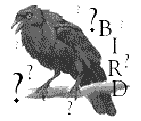NSS Home Page
 Question Bird
Question Bird
|


|
Send us your questions about recording techniques and equipment, places to visit, or anything else related to the sounds of nature, and we'll do our best to give you answers here.
You can reach us by email at questionbird@naturesounds.org |
|
Q - Urgently need advice on a good microphone(s?) to use with my just-ordered
TASCAM DA-P1 portable recorder. I plan on recording ambient sound of the highest possible quality at locations like meadows, streams, desrts, forests, etc. I have a budget in the $500 range for a mike, and would like for it to have a fairy wide capture ratio...the idea is to get a spacious feeling for the location. This sound track will be synced to video I'll be shooting at the same time.
Many thanks for any help, Arthur Hancock Time Capsule Video katieart@dnet.net A- The simplest solution to your need would be an M-S stereo microphone. The Audio-Technica AT825 is an economical example. It has balanced outputs. There's also the AT822, with relaxed specifications and unbalanced outputs. The Shure VP-88 is another one, costing around $1000. M-S mikes have advantages and disadvantages. Advantages are stereo from one unit so one zeppelin windscreen can be used, and excellent mono compatibility. A disadvantage is that there is no time difference between the channels, so the sense of space in headphones is limited. Another approach is to mount a pair of cardioid pattern mikes (like Sennheiser K6 series) on a stereo bar in an "ORTF" (French Radio) configuration. This gives good stereo localization on both speakers and headphones, excellent spaciousness on headphones, and acceptable mono compatibility. A disadvantage is the array is too big to fit into one zeppelin, and two zeppelins can't get close enough together. Using exaggerated spacing might be ok, though. A third possibility would be a home-brew quasi-binaural rig with two omni mikes mounted on a head-sized ball. Ask Lyman Miller about that. The DAT and video can be expected to hold synch accurately for a few minutes, maybe longer depending on your luck in getting crystals in the two machines that agree. -Dan Dugan Q - My wife and I will be heading to SE Asia soon, and I'm trying to keep recording equipment weight and bulk down. My present Marantz analog system is OK, but I was thinking of a small SONY DAT recorder. What is the current model, and is it about the same size as the old? Would you recommend DAT over mini-disc? Does any other company make a small digital recorder? Finally, where can I get the best price? - Herb Melchior, Alaska A - The current ultra-small SONY DAT model is the TCD-D8. It has a black case, instead of grey, but other differences from the older TCD-D7, including size, are relatively minor. The TCD-D8 is 5-1/4" x 1-1/2" x 3-1/2" (w/h/d). For nature sound recording, a DAT machine likely is preferable over a mini-disc machine, because DAT recording loses, or "drops," less sound information than does mini-disc recording. To my knowledge, no other company makes a readily-available digital recorder with the ultra-small dimensions of the SONY TCD-D8, and certainly not for under $1,000. Some words of caution, however. You will need a separate speaker for playback, and I've heard the TCD-D8 is relatively sensitive to being dropped. I have solved the speaker problem with a Realistic mini amplified speaker #40-1313 (Radio Shack), and (in part, at least) the drop sensitivity problem with a small padded carrying case for point-and-click cameras (most camera supply shops). The speaker is just the right size and shape to fit into the large, main (zippered) pocket of the carrying case, while the TCD-D8 is just the right size and shape to fit into the smaller, front (zippered) pocket. The whole thing (recorder, speaker, and carrying case) makes a wonderfully compact, lightweight (3.25 lbs, with 4 "C" alkaline batteries), and well-insulated recording unit. For best price, Eber Electronics and Audio Images (both in San Francisco) offer substantial price discounts to Bay Area Nature Sounds Society members. In the spring of 1996, the TCD-D8 listed for $799, and I purchased my unit from Eber for $649. For mail order, Marice Stith Recording Services in Ithica, NY has good prices. - William Gilbert Q - I would like to use my Sennheiser stereo microphones with the Sony TCD-D8 recorder, but have heard that stereo mikes require a pre-amp to use with this unit, and that the pre-amp is nearly as expensive as the recorder. Is there any cheaper solution? Can I get good-quality recordings with the TCD-D8? - Paul Feyling, San Francisco A - Some stereo mikes might require a pre-amp, a separate power supply, and a special cable (could all be a unit) for them to work properly with a TCD-D8. But this would be a function of the type of microphone or microphones you have, not specifically a function of the TCD-D8. Certainly, many stereo and mono mikes work quite well, with no special attachments, with the TCD-D8. If you have microphones requiring special attachments, there probably is no alternative to paying the price for those attachments, outside of building you own (which is possible). The SONY TCD-D8 can give you excellent, professional-quality recordings. A major drawback with the unit, however, is that it is quite fragile. For its very low price, you sacrifice ruggedness. The larger (but still portable) DAT machines will stand quite a bit more field abuse. But the HHB PDR 1000TC goes for about $6,500, a StellaDAT for about $11,000, and even the SONY TCD-D10Proll will cost you about $3,300. So it's worth knowing how to take care of your TCD-D8, if you own one. I recommend that you get a well-padded carrying case that will accomodate your recorder and a small amplified speaker. Then, get cords with right-angle male jacks for your microphone, earphone, and speaker (or possibly retrofit existing, hard-wired cords). The TCD-D8 female recorder jacks are sensitive to shear damage from straight connectors. Finally, when you change tapes or batteries, kneel or sit, and provide a soft landing spot (jacket, your lap, etc.) in case you should accidentally drop your recording unit. - Lyman Miller |

|
This site and its contents copyright © 1996-2003 The Nature Sounds Society. About this web site |

|
